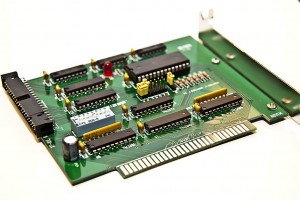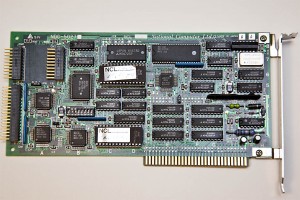Once I started messing with my IBM PC XT, I realized that there were things I had taken for granted all along since my first PC compatible system was a 386. I didn’t realize that IDE uses a 16-bit bus and it would take some trickery to use an IDE device in an older 8-bit system like the XT. I searched around and found that there were in fact 8-bit ISA controllers but they were expensive and rare. Finding one these days would be a stroke of luck or a dent in the pocket book. I was about to design my own when I came across the XT-IDE project. The XT-IDE project is an open source venture where a group of people designed exactly what I needed with fairly common off-the-shelf parts. I had my friend James to burn the code onto the eeprom for me because I have no way to put something on a 360K floppy disc but aside from that, the project primarily consists of easy through-hole soldering.
I ordered my board the other day from Andrew Lynch who can be found lurking in this huge forum thread. It was $14 including shipping which I felt was more than fair considering the quality of the board. It’s a very professional dual-sided PCB with a full solder mask and silkscreen. It would take me far too much time to attempt to replicate this at home. It’s also nice that it has all of the settings printed VERY clearly on the board and the url for www.vintage-computer.com so I won’t forget where I found this project.
The bill of materials looks a little daunting at first but it’s really not a huge project. The list below references Jameco part numbers. There are a few non-critical items and some others that you can pillage from other ISA cards such as an L-bracket, pan screws and shorting blocks (jumpers). I’m personally going to skip using most of the sockets since I’m fairly confident with my soldering skills and dual-wipe sockets tend to add another point of failure.
1 XT-IDE PCB (get this from Andrew lynch) 10 25523 CAP,MONO,.1uF,50V,20% 1 1945428 CAP,RADIAL,47uF,35V 2 45129 IC,74HCT688 1 46316 IC,74LS04 1 46607 IC,74LS138 1 47466 IC,74LS32 1 287144 IC,74F245,DIP-20 3 282642 IC,74F573,DIP-20 1 74827 Atmel EEPROM IC, 28C64 2 112214 SOCKET,IC,14PIN,DUAL WIPE 6 112248 SOCKET,IC,DUAL WIPE,20PIN 1 112272 SOCKET,IC,DUAL WIPE,28PIN 1 526205 SOCKET,IC,16 PIN,390261-4 3 112432 SOCKET,SHORTNG BLKS,RED,CLSE 1 690662 RES,CF,150 OHM,1/4 WATT,5% 6 691104 RES,CF,10K OHM,1/4 WATT,5% 2 857080 MOLDED SIP,9PIN,BUSSED,10K,2% 1 333949 LED,GREEN,572NM,T-1 3/4 1 1939562 SWITCH,DIP,SPST,8-POS,16-PIN 1 53604 HEADER,RT MALE,2RW,40 CONT 1 109568 HEADER,.1 ST MALE,2RW,16PIN 1 109576 HEADER,.1 ST MALE,1RW,3PIN 2 2094389 SCREW,PAN HEAD,PPN4-40X1/4 1 N/A Keystone 9202 ISA bracket with 2 PCB mounting tabs.
Once I had all of the parts together, it was time to check out the build instructions. This project is a VERY easy build. All of the IC’s are labeled on the PCB, all of the caps are identical except one which is labeled and called out and all of the resistors are the same aside from the one that goes with the LED. There are only two gotchas that I can think of. First off, before you solder in the 40 pin IDE connector, you should pull the key pin out from the connector. Grab an IDE cable and line it up with your connector, you will see which one is the key pin fairly quickly. Secondly, the default dip switch setting is correct on the back side of the PCB but incorrect in the build instructions. Set it to 01110111 as stated on the back of the card. If you need to set this to a different setting, you will need to re-flash the firmware on the eeprom for some reason. The default seems to work fine however so no big deal.
Overall this project has cost me about $30. I’ve learned some new stuff and I can now use my IBM PC XT with a modern IDE hard drive. My next step will be to try to use the system with a compact flash card. Now I can install MS-DOS 6.22 and hopefully Xenix at some point without disrupting the original MS-DOS 3.2 file system.
If you like the content on this site, please support it by using this link to order from Amazon. You know you were going to go there and buy stuff anyhow so why not help me pay the hosting bill.





would you be willing to build one of these for me? if yes, what price? i need one for a Tandy 1000 TL/2 that has (for unknown reasons) decided that the XT IDE drive will black the display (computer is okay if the drive is unplugged but i really want a hard drive in there & there are no XT IDE or SmartDrive hard drives on the market at any reasonable cost).
Is your power supply up to the task? Have you tried using a separate power supply on the hard drive to make sure that isn’t dragging down the system? A ide-cf adapter might be a good item to try too since the power requirements are very low for that. Sure I could build you a card but I’m not convinced that it would solve your problem. What IDE controller card are you using now?
Thanks for the response (is there a better way to get in touch?)
My Tandy 1000 TL/2 has a built-in XT IDE controller on the mainboard (the IDE is often referred to as “SmartDrive”). The power supply is what came built with the machine and i see no obvious power ratings labels. Could the PSU be dying in such as way as to offer less power? i assume though that if it were the power supply, the drive being powered on would cause the same problem even if the IDE cable was unplugged. That’s not the case.
Everything worked fine as is (hard drive & MPU-401 MIDI card) until a week ago . The problem started as intermittent than became consistent. Remove the drive’s IDE connector and the video works again.
One of the best ways to find me is in the IRC channel irc.freenode.net #zipit-dev. Feel free to PM me on there.
Yes, the PSU could certainly be dying. When old electrolytic capacitors dry out, things can start to get flaky. I would still suggest finding an old AT style power supply and try powering the drive off of that.
dying capacitors… sounds scary. don’t know if i’d ever find a power supply to replace the one this machine came with.
Just about an hour ago, i reseated the four DRAM chips to see if that would help… The display is working again with the hard drive enabled. It did go blank on me once so far shortly after that, but it’s been ok for almost an hour now. i have a multimeter but don’t know electronics so well. i suppose i could look at the voltages on the drive power… beyond that, i’m at a loss.
Regarding compact flash… i’d LOVE to replace the hard drive with CF, but the controller is XT IDE and i’m working with the understanding that XT IDE is so old as to be unsupported by ANY devices still being built (it’s not the standard IDE we know from 386 and up PCs).
Actually, now that you mention that reseating DRAM’s somewhat fixed it, you gave me another idea. Take your motherboard out entirely and check on the solder side for bad/thin/cracked solder joints. Reseating the drams could have worked something temporarily back into place that is flaky but touching up the solder might be a permanent fix.
can you still make these XT IDE controler cards? I would need 2. I have 2 Tandy 1000 computers that used to boot off my MFM drives but the drives no longer boot. Ive been wanting to convert to IDE for a long time now. Can you help?
Alex
Last time I tried to track down the PCB, I couldn’t find it but I talked to someone at my local vintage computer club and he told me there was actually a newer version of the board with more features. I only needed one for the moment so that’s all I built but I might get motivated to build another one someday here. If I do, I’ll blog about it.
The new boards are coming out in early August. They’ll run about $14, and maybe another $20 for parts. Are you interested in getting one (and perhaps assembling another for me)?
Do you have a link to where they will be selling the new boards?
Here’s a thread: http://www.vintage-computer.com/vcforum/showthread.php?27152-Forthcoming-XT-IDE-Board-Cast-Your-Vote
(Go to the last page.)
I’m on the list of interested members, so I received a PM from the thread author that says the board will be out in August.
Hello,
My name is Tiago and I am restoring an Amstrad PC 1512. I feel problems because the PC don’t have a factory Hard disk. So, where I can buy all the stuffs that I need for? Could you help me?
Thank you in advance!
Best regards!
Care to build one and sell it? I don’t have the time or tools to fab one, but I have a need for one!
Regards